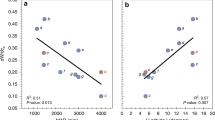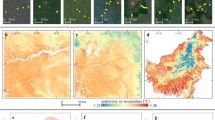Abstract
Tropical forests are incredibly dynamic, showing rapid and longer-term changes in growth, mortality and net primary productivity1,2,3. Tropical species may be highly sensitive to temperature increases associated with climate change because of their narrow thermal tolerances. However, at the ecosystem scale the competing effects of temperature, light and precipitation on tropical forest productivity have been difficult to assess. Here we quantify cloudiness over the past several decades to investigate how clouds, together with temperature and precipitation, affect flower production in two contrasting tropical forests. Our results show that temperature, rather than clouds, is critically important to tropical forest flower production. Warmer temperatures increased flower production over seasonal, interannual and longer timescales, contrary to recent evidence that some tropical forests are already near their temperature threshold4,5. Clouds were primarily important seasonally, and limited production in a seasonally dry forest but enhanced production in an ever-wet forest. A long-term increase in flower production at the seasonally dry forest is not driven by clouds and instead may be tied to increasing temperatures. These relationships show that tropical forest productivity, which is not widely thought to be controlled by temperature, is indeed sensitive to small temperature changes (1–4°C) across multiple timescales.
This is a preview of subscription content, access via your institution
Access options
Subscribe to this journal
Receive 12 print issues and online access
$209.00 per year
only $17.42 per issue
Buy this article
- Purchase on Springer Link
- Instant access to full article PDF
Prices may be subject to local taxes which are calculated during checkout



Similar content being viewed by others
References
Nemani, R. R. et al. Climate-driven increases in global terrestrial net primary production from 1982 to 1999. Science 300, 1560–1563 (2003).
Phillips, O. L., Lewis, S. L., Baker, T. R., Chao, K-J. & Higuchi, N. The changing Amazon forest. Phil. Trans. R. Soc. Lond. B 363, 1819–1827 (2008).
Lewis, S. L., Malhi, Y. & Phillips, O. L. Fingerprinting the impacts of global change on tropical forests. Phil. Trans. R. Soc. Lond. B 359, 437–462 (2004).
Clark, D. A., Piper, S. C., Keeling, C. D. & Clark, D. B. Tropical rain forest tree growth and atmospheric carbon dynamics linked to interannual temperature variation during 1984–2000. Proc. Natl Acad. Sci. USA 100, 5852–5857 (2003).
Doughty, C. E. & Goulden, M. L. Are tropical forests near a high temperature threshold? J. Geophys. Res. 113, 1–12 (2008).
Saugier, B., Roy, J. & Mooney, H. A. Estimations of global terrestrial productivity: Converging on a single number? Terrest. Glob. Product. 543–557 (2001).
Dirzo, R. & Raven, P. H. Global state of biodiversity and loss. Annu. Rev. Environ. Resour. 28, 137–167 (2003).
Kingsolver, J. G. The well temperatured biologist. Am. Natural. 101, 755–768 (2009).
Janzen, D. H. Why mountain passes are higher in the tropics. Am. Natural. 174, 233–249 (1967).
Root, T. L., Price, J. T., Hall, K. R. & Schneider, S. H. Fingerprints of global warming on wild animals and plants. Nature 421, 57–60 (2003).
Parmesan, C. Influences of species, latitudes and methodologies on estimates of phenological response to global warming. Glob. Change Biol. 13, 1860–1872 (2007).
Wielicki, B. A. et al. Evidence for large decadal variability in the tropical mean radiative energy budget. Science 295, 841–844 (2002).
Graham, E. A., Mulkey, S. S., Kitajima, K., Phillips, N. G. & Wright, S. J. Cloud cover limits net CO2 uptake and growth of a rainforest tree during tropical rainy seasons. Proc. Natl Acad. Sci. USA 100, 572–576 (2003).
Huete, A. R. et al. Amazon rainforests green-up with sunlight in dry season. Geophys. Res. Lett. 33, 2–5 (2006).
Wright, S. J. & Calderón, O. Seasonal, El Niño and longer term changes in flower and seed production in a moist tropical forest. Ecol. Lett. 9, 35–44 (2006).
Zimmerman, J. K., Wright, S. J., Calderón, O., Pagan, M. A. & Paton, S. Flowering and fruiting phenologies of seasonal and aseasonal neotropical forests: The role of annual changes in irradiance. J. Trop. Ecol. 23, 231–251 (2007).
Clark, D. A. Sources or sinks? The responses of tropical forests to current and future climate and atmospheric composition. Phil. Trans. R. Soc. Lond. B 359, 477–491 (2004).
Malhi, Y., Doughty, C. & Galbraith, D. The allocation of ecosystem net primary productivity in tropical forests. Phil. Trans. R. Soc. Lond. B 366, 3225–3245 (2011).
Roderick, M., Farquhar, G., Berry, S. & Noble, I. On the direct effect of clouds and atmospheric particles on the productivity and structure of vegetation. Oecologia 129, 21–30 (2001).
Hollinger, D. Y., Kelliher, F. M., Byers, J. N., Hunt, J. E. & Mcseveny, T. M. Carbon dioxide exchange between an undisturbed old-growth temperate forest and the atmosphere. Ecology 75, 134–150 (1994).
Min, Q. Retrievals of thin cloud optical depth from a multifilter rotating shadowband radiometer. J. Geophys. Res. 109, 1–10 (2004).
Wright, S. J. & Cornejo, F. H. Seasonal drought and leaf fall in a tropical forest. Ecology 71, 1165–1175 (1990).
Cavelier, J., Wright, S. J. & Santamaria, J. Effects of irrigation on litterfall, fine root biomass and production in a semideciduous lowland forest in Panama. Plant Soil 211, 207–213 (1999).
Nepstad, D. C., Tohver, I. M., Ray, D., Moutinho, P. & Cardinot, G. Mortality of large trees and lianas following experimental drought in an Amazon forest. Ecology 88, 2259–2269 (2007).
Phillips, O. L. et al. Drought sensitivity of the Amazon Rainforest. Science 323, 1344–1347 (2009).
IPCC Climate Change 2007: The Physical Basis (eds Solomon, S. et al.) (Cambridge Univ. Press, 2007).
Raich, J. W., Russell, A. E. & Vitousek, P. M. Primary productivity and ecosystem development along an elevational gradient on Mauna Loa, Hawai’i. Ecology 78, 707–721 (1997).
Berry, J. A. & Bjorkman, O. Photosynthetic response and adaptation to temperature in higher plants. Annu. Rev. Plant Physiol. 31, 491–543 (1980).
Foster, R. B. in The Ecology of a Tropical Forest Seasonal Rhythms and Long-term Changes (eds Leigh, E. G., Rand, A. S. & Windsor, D. M.) 151–172 (Smithsonian, 1982).
Clark, D. B., Clark, D. A. & Oberbauer, S. F. Annual wood production in a tropical rain forest in NE Costa Rica linked to climatic variation but not to increasing CO2 . Glob. Change Biol. 16, 747–759 (2010).
Acknowledgements
We thank K. Knapp at NOAA NCDC for providing a beta version of the full GridSat data set, and D. K. Okamoto for input on statistical analyses, and are also grateful to H.G.B. This work was conducted as a part of the Forecasting Phenology Working Group supported by the National Center for Ecological Analysis and Synthesis (NCEAS), a Center funded by the NSF (Grant #EF-0553768), the University of California, Santa Barbara, and the State of California. The BCI portion of the study was supported by funds from the Environmental Sciences Program and the Center for Tropical Forest Science of the Smithsonian Institution. At Luquillo research was supported by NSF grant DEB-0639393 and by NSF funds (BSR-8811902, DEB-9411973, DEB-008538, DEB-0218039 and DEB-0620910) to the Luquillo Long-Term Ecological Research Program. S.P. was a Postdoctoral Associate supported by NCEAS. E.M.W. was supported by the NSERC CREATE training programme in biodiversity research.
Author information
Authors and Affiliations
Contributions
S.P., B.I.C., E.M.W. and S.J.W. developed and designed the primary analyses. S.P. and J.R. analysed satellite data and developed cloud detection algorithms. J.K.Z., C.J.N. and S.J.W. curated and assisted with interpretation of the flower production and meteorological data. S.P. performed all analyses and wrote the first draft of the manuscript. All authors discussed the results and helped edit the manuscript.
Corresponding author
Ethics declarations
Competing interests
The authors declare no competing financial interests.
Supplementary information
Rights and permissions
About this article
Cite this article
Pau, S., Wolkovich, E., Cook, B. et al. Clouds and temperature drive dynamic changes in tropical flower production. Nature Clim Change 3, 838–842 (2013). https://doi.org/10.1038/nclimate1934
Received:
Accepted:
Published:
Issue Date:
DOI: https://doi.org/10.1038/nclimate1934
This article is cited by
-
Cascading effects of climate change: new advances in drivers and shifts of tropical reproductive phenology
Plant Ecology (2024)
-
Independent, but not synergistic, effects of climate and landscape structure drive pollination and subsequent reproduction in a tropical plant, Heliconia tortuosa
Landscape Ecology (2022)
-
Plant dynamics in a tropical dry forest are strongly associated with climate and fire and weakly associated with stabilizing neighborhood effects
Oecologia (2021)
-
Climate change scenarios and projected impacts for forest productivity in Guanacaste Province (Costa Rica): lessons for tropical forest regions
Regional Environmental Change (2020)
-
A novel cellular automata approach: seed input/output of the alien species Leucaena leucocephala in the soil and the effects of climate changes
Plant Ecology (2020)



